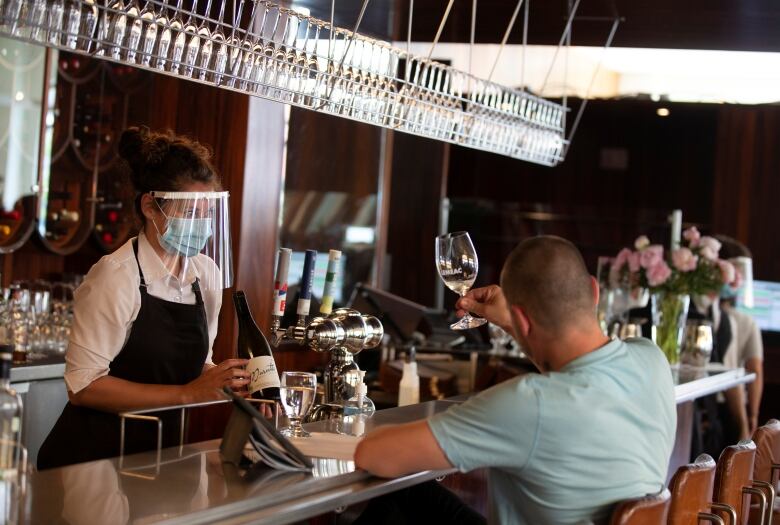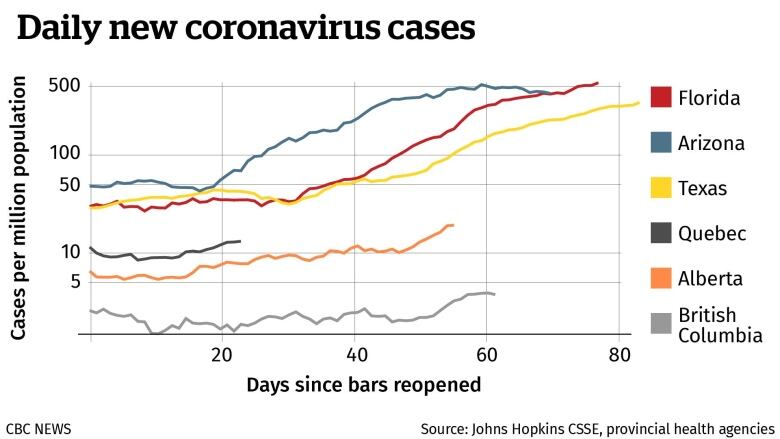The key metric that will tell us if Canada is headed for a U.S.-style COVID-19 crisis
One top health official lost sleep over reopening B.C. bars but is now confident outbreaks are manageable

This is an excerpt fromSecond Opinion, aweeklyroundup of health and medical science news emailed to subscribers every Saturday morning.If you haven't subscribed yet, you can do that byclicking here.
A recurring fear looms over newly reopened bars and restaurants, lurking over crowded aisles, clinking glasses and face-to-face banter enlivened by alcohol.
Are we sleepwalking toward an American-style coronavirus crisis?
As Canadian establishments reopen,it's a worry voiced even by some people with a financial stake in the hospitality business.
Two Montreal restaurateurs said they were aghast at behaviour they witnessed after businesses resumed operating several weeks ago.
"Frustrated. Angry. Disheartened," is how Stephen Leslie, owner of Tavern on the Square and Monkland Tavern, describes his reaction to seeing other establishments defy safety guidelines, with too many tables and too little PPE for staff.
"You just can't help but think that what's going on to the south of us Texas, Florida how they've been forced to re-close is going to happen to us here if we don't follow the rules."

Ilene Polansky, owner ofMontreal restaurantMaestro SVP, said disrespectful clients littered; stumbled into her; did not distance; refused to wash their hands; and stormed off when she declined to group tables together.
"They said, 'One-star review for you. We're never coming [back] here,'" Polansky recalled.
"It's sad that I have to tell people to follow the rules."
Now Montreal has long lineups for testing, with infections rising and dozens of cases linked to bars, prompting new provincial guidelines.
Alberta faced 41 new cases tied to outbreaks at four restaurants in Edmonton late last month. British Columbia has seen exposure to COVID-19 in bars, nightclubs and strip clubs since reopening. Ontarioreopened bars and restaurants in much of the province Friday as it moves into Stage 3.
The post-reopening spikes inevitably raise questions about whether Canada is simply a few weeks behind a neighbour that reopened sooner.
In the U.S., a new wave of the virus is battering virtually every region, with cases rising in most states; record spikes in several of them; and hospital bed shortages in Florida and elsewhere.
To gauge whether the early signs in Canada point to a scenario similar to the one flaring up through the U.S., CBC News consulted three infectious disease experts, four public health officials, and national, state and provincial data.
One of Canada's best-known public health experts said she lost sleep over the decision to reopen bars in B.C. but she's now confident in their ability to clamp down on outbreaks quickly before they spiral out of control.
"We've had our restaurants and bars open for the last month now, and we haven't had major outbreaks," Dr. Bonnie Henry said in an interview with CBC News. "It's not been perfect, and we've had to revise things."
Henry said B.C. reopened establishments in a "manageable" way that allowed people to socializesafely, with smaller capacities,strict physical distancing and hygieneprotocols, anda COVID-19 safety plan in place.
"The first thing people said when we had the exposure event in a couple of the nightclubs in Vancouver was, 'Oh, shut them down.' But that doesn't help," she said, adding officials worked with the industry to minimize risk to patrons and staff.
"Itjust drives people underground, where we won't hear about cases because they're afraid to talk about it."
'You can't eat and drink with a mask on'
When trouble hit the United States, it initially struck with stealth as a series of anecdotes, unheeded warnings, contradictory news headlines, and videos of safety guidelines being ignored.
Within days the headlines took an unambiguously bleaker turn.Arizona reported its highest one-day increase in cases. Then the cases kept growing, and growing, thendoubling, tripling, quadrupling.

Now Canada is also reopening what experts describe as some of the highest-risk environments bars and restaurants.
People are indoors, in close contact, sharing food and drinking while proven infection-control measures like physical distancing, hand hygiene and mask wearing are also much harder to maintain.
"You can't eat and drink with a mask on," said Dr. Matthew Oughton, an infectious disease specialist at the Jewish General Hospital and an assistant professor at McGill University in Montreal.
The spread of COVID-19 among bar-goers who aren't displaying symptoms is another major risk factor.
"The risk is that you could be feeling totally fine and ready to go for a night out," he said. "And your dining partner might be infected, or you might be infected and yet not know it."
Oughton said the biggest challenge for public health officials is catching those outbreaks from bars and restaurants early enough to stop them from "snowballing" into larger threats to the community.
He said they need to focus onisolating positive cases and contact tracing to ensure the virus doesn't spread in the community unchecked after an outbreak.
"We are sitting in a forest that is bone-dry and there are lots of places where sparks might flare up," Oughton said.
"So you can stomp out the first spark, you can stomp out the second spark, what worries me is if there's 100 different sparks starting 100 small brush fires, can you actually stomp out all of them in time?"
WATCH |B.C. and Quebec hurry to trace new COVID-19 clusters
But the statistic to watch, according to one U.S. epidemiologist: the percentage of people testing positive for coronavirus, and which directionit goes.
That's a metric Jennifer Nuzzo follows closely as a leading indicator of where case totals are headed.
If it starts to move down, that's good news; if it moves up, that's a red flag that more cases are being missed, more people are unwittingly spreading the virus, and there's a growing chance it might spiral out of control.
"I pay a lot of attention to positivity," said Nuzzo, an epidemiologist at Johns Hopkins Bloomberg School of Public Health.
"If it starts to pick up, that's, I think, a worrisome development."
The goal set by the World Health Organization is to keep positive test rates below fiveper cent.
By that standard, the U.S. is in brutal shape. A whopping 33 U.S. states had rates higher than the WHO benchmark on Thursday, with several just above or just under 20 per cent.
Canada has far lower positivity rate thanU.S.
That's exhibit A in the difference between Canada and the U.S..
U.S. states were indisputably in worse shape when they reopened indoor social establishments:
Arizona's positivity rate was around six per cent when it allowed restaurants and some bars to reopen on May 11 and has surged to a recent peak of 26.9 per cent, according to figures compiled by Johns Hopkins. TheTexas ratehovered above five per cent this spring during the weeks it reopened, and is now at 16 per cent.Florida reopened restaurants in most places on May 4 and bars onJune 5, a period during which test-positivity rates were between two and five per cent and then started surging to a peak near 20 per cent.

Canada is simply not in that ballpark.
In Montreal, even after its latest spike, the positivity rate inched upward, from a low under one per cent to three per cent this week. Quebec overall has a positivity rate of 1.4per cent;British Columbia and Ontario both sit at about 0.8 per cent positivity; andAlberta hovers around1.7 per cent.
More than 3.3 million Canadians have been tested for coronavirussince the pandemic began, with a positivity rate of about three per cent.

U.S. states reopened with little regard for such metrics, said Dr. Abraar Karan, a physician and public health researcher at Harvard Medical School who is aiding the Massachusetts pandemic response.
He said the U.S. could have avoided a spike in cases from reopening if it had simply taken its own advice: in May, the U.S. Centers for Disease Controland the White Housepublished careful step-by-step guides to reopening based on scientific benchmarks.
"The thing is, none of those were actually implemented at the state level across the United States," Karan said.
Right after the White House published those guidelines, however, the president of the United States was essentially brushing them off, calling on states to reopen in a series of all-caps tweets like, "LIBERATE MICHIGAN!"
That illustrates another difference between the countries: politics.
Canada has not had as vocal a chorus of coronavirus-doubters in its media and political establishments.

Attempts to lock down the U.S. have prompted armed protests; numerous lawsuits; and open defiance of efforts to shut down bars.
Even now, the governor of Georgia is preventing cities from imposing masks.
And while the numbers are shifting, as the U.S. grapples with this ongoing wave, data collected by Google from people's smartphones showed Canadians doing far more physical distancing than Americans in the winter and spring.
"What happened in the States is that they did a fast reopening, before they even came close to settling down their first wave. So what's going on now is not a second wave, it's a continuation of the first wave," Oughton said.
"Whereas it's very safe to say that in Quebec and, in fact, across Canada we really have largely controlled it."
To read the entireSecond Opinionnewsletter every Saturday morning, subscribe byclicking here.
With additional reporting from Debra Arbec in Montreal














_(720p).jpg)


 OFFICIAL HD MUSIC VIDEO.jpg)
.jpg)



























































































